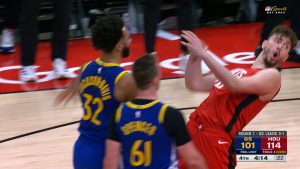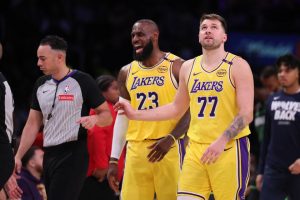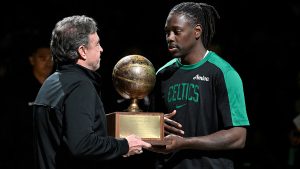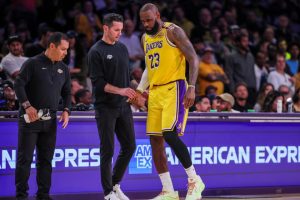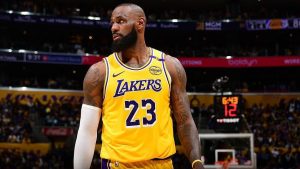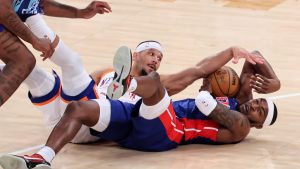NEW YORK — Tom Thibodeau expected a furious charge from a Detroit Pistons team with its collective back against the wall in Game 5, but — and you’re not going to believe this — he insisted that neither he nor his New York Knicks were going to change their approach.
Yes, Thibs allowed before tipoff on Tuesday, the closeout game is the hardest one in any series — with all due respect to Andrew Bynum — because “you know you’re going to get great intensity in the game.” And that kind of challenge demands a redoubling of your own efforts: more intensity, more intelligence, more togetherness. Forty-eight minutes of hell: nothing more, nothing less.
“The way we have to look at it is, ‘What is it going to take to win the game?’” Thibodeau said during his pregame news conference.
You’d presume his keys to victory did not include “committing a 24-second violation on the first possession of the game, and another one on the first possession of the third quarter.”
Those were two of the four times New York has allowed the entire shot clock to dwindle without getting a shot on the rim in its first-round matchup with Detroit. The Knicks have also turned the ball over twice in five games by failing to get the ball across half-court within eight seconds of inbounding it; the entire rest of the postseason field has combined for three such violations.
Those half-dozen possessions by themselves don’t constitute the difference between the Knicks having already closed the series out and leaving the job unfinished, with the Pistons staving off elimination on Tuesday to force a Game 6 in Detroit on Thursday. They do, however, highlight an issue that has plagued Thibodeau’s team at times throughout the series: The Knicks are playing slow, and it’s costing them.
New York’s average offensive possession in the first round has lasted 15.84 seconds, according to PBP Stats — about a half-second slower than its average offensive pace during the regular season, which was already the NBA’s third-slowest. The Pistons, by comparison: 14.37 seconds per offensive possession, nearly a second and a half faster, and No. 2 in the postseason, behind only the Oklahoma City Thunder.
“We’re at our best when we’re able to play early in the clock,” Pistons head coach J.B. Bickerstaff said before Game 5. “You go back and look at our early actions, and they’ve been our best, most efficient offense.”
The numbers bear that out. The Pistons have averaged 119.2 points per 100 plays in transition in this series, compared to just 89.6 points-per-100 in the half-court, according to Cleaning the Glass, and their effective field-goal percentage (which accounts for 3-pointers being worth more than 2-pointers) in the firstsix seconds of a possession is dramatically higher than it’s been late in the clock.
What’s true for Bickerstaff’s team is generally true for most; whether you’re running a restaurant hunting for a Michelin star or an NBA offense hunting for points, every second counts. That’s not, however, the way the Knicks typically play.
During the regular season, 15.5% of New York’s offensive possessions ended with four or fewer seconds left on the shot clock, according to Synergy — the second-highest share in the NBA. Against Detroit, that has ballooned to 20.7% — the second straight postseason in which the Knicks have led the league in late-clock possessions.
To some degree, that is the residue of design.
New York’s pilot, Jalen Brunson, is one of the NBA’s premier pick-and-roll and isolation shot creators, most comfortable working to manipulate the defense to try to pick a preferred matchup and angle of approach that he can exploit to generate a good look — or, failing that, to create enough space for a tough one that he can make. Given Brunson’s sure-handed control of the ball, leaning into that sort of one-on-one attacking also tends to be a good way to avoid turnovers — a critical component of Thibodeau’s offensive philosophy. And in this matchup specifically, with the Pistons being the younger, more athletic and less experienced team, forcing them to remain on point for the duration of a 24-second possession would in theory create more opportunities for them to make a mistake that Brunson and the rest of the Knicks’ offensive skill players can exploit.
In practice, though, New York’s much ballyhooed starting five hasn’t exploited very much, carrying over its underwhelming final few months of the regular season by getting outscored by 13 points in 118 minutes through five games. Detroit’s starters, on the contrary: plus-43 in 71 minutes, the best mark of any five-man unit in these playoffs.
A lot of that margin has come on the defensive end, where the Pistons have largely been equal to the task of stifling New York and deserve plenty of credit for tightening the screws. The high pickup points the Pistons have used and the full-court pressure they have applied, primarily with Ausar Thompson and Dennis Schröder picking up Brunson the full 94 feet, is influencing the Knicks into shaving extra seconds off the clock before getting the ball across the timeline — and has often led New York to have other players, chiefly Josh Hart and Mikal Bridges, bring the ball up the court while Brunson gets face-guarded away from the play.
The physicality with which Detroit’s playing off the ball — whether it’s Thompson working to prevent Brunson from even being able to break free to receive a pass, Tobias Harris bodying up Karl-Anthony Towns before the catch, or wings like Tim Hardaway Jr. and Malik Beasley fighting to make sure the Knicks’ perimeter players can’t easily draw them into screening actions — has helped keep New York from cleanly and quickly getting into its actions. The Pistons’ attention to detail in transition, getting multiple players back after a shot attempt — and, more often in Game 5 than in Games 3 and 4 in Detroit, finding Towns on the delayed break to take away his trail 3-point looks — has also helped limit New York’s early-offensive opportunities, forcing Brunson and Co. to reset and cycle through their options.
“Obviously, you want to try to attack early, before they’re set,” Thibodeau said. “But then, if they have the third and fourth defender back, now get organized and have structure, and then have creativity along with the structure. And so, you’ve got to read what’s going on — read the man in front, get to the next action. Everyone move together and create advantages for each other.”
Every early defensive effort pays dividends later on, with each tick-tick-tick where the ball doesn’t even start heading toward the rim until more than half the possession has elapsed, drawing the Knicks closer to having to launch a late-possession grenade and hope for the best:
That can work: Brunson, just crowned the NBA’s Clutch Player of the Year, and Towns, who has drilled some massive late-game shots during New York’s wins in this series, are good enough to reward the forays deep into the clock. It’s exceedingly tough sledding, though — and, in this series, it hasn’t worked nearly as well as New York’s top-five regular-season ranking in offensive efficiency would suggest. The Knicks are scoring just 0.856 points per possession on those final-four-seconds shot attempts, according to Synergy — down from 0.997 points per possession on their other 345 half-court plays in this series.
“We’re better with pace,” Towns said after Game 5. “When we’re executing at a high level, we’ve shown in this series how good we can be.”
They showed it for stretches in Game 5, too. When the Knicks did play like they heard the clock ticking — whether pushing off a Pistons miss, moving the ball with a purpose to change sides of the floor, or even just initiating their offense a few beats earlier, sprinting up to set a screen rather than loping into one — they often gave themselves either a better chance of success on the initial action or, even better, a second chance to beat a defense that was already in motion:
“We kept finding ourselves having spurts of energy,” Towns added. “You know, when you’re playing a game like this, in a 3-1 lead, to end the series you’ve got to have that kind of pace for 48 minutes.”
One key to maintaining that pace? Generating misses and turnovers.
“I think something that we can do to stop that [offensive stagnation] is be better defensively, and get stops and get out and run,” Hart said. “You know, when you’re taking the ball out the rim every time you’re taking it out, it slows it up. It allows them to pick [us] up full [court]. So we’ve got to make sure we continue to get stops and finish those possessions with rebounds, and then get out and run.”
Hart has a point. Like Detroit, New York’s offense has been markedly better in transition (112.5 points-per-100) than against the Pistons’ half-court defense (95.1 points-per-100), with its average first shot following a defensive rebound (9.8 seconds, third-fastest in the playoffs) coming nearly 7.5 ticks faster than after a Detroit make (17.2 seconds, dead last).
An injection of pace and movement might also help the Knicks shake off the sluggishness that has seemed to plague them coming out of the locker room at halftime.
“As a team, we recognized that the first quarters, they were doing well, and we responded in a certain way when it comes to that. But now we’ve got to do the same thing for the third quarter, and the beginning of the second half,” Brunson said after Game 5. “It’s a really important first couple of minutes, and I think tonight they took advantage of that.”
Detroit’s been taking advantage of it all series, seizing the opportunity to jump the Knicks post-intermission. For the series, New York is plus-10 in first quarters, plus-7 in seconds, plus-21 in fourths … and minus-33 in third quarters, having given up double-digit Detroit runs in all five games to put themselves behind the 8-ball in the second half.
“I don’t know, man. I think we maybe gotta do some layup lines or something coming out of half, man,” Bridges said. “Get everybody out there, you know, moving.”
More and faster motion (ideally not into the same foot of space) sure seems like it would help a Knicks team that has turned in three of its 13 worst offensive performances of the season in this series. At this stage, though — with Brunson and Hart clearly nursing injuries that caused them to be taken off the floor in crunch time of Game 5, with the Knicks collectively moving at the fourth-slowest average offensive speed in the playoffs, and with Detroit locked into everything they’re running — it’s not clear how much quicker the Knicks can move, or how quickly they can find new answers good enough to finish off the Pistons.
“It’s the playoffs, so I think you have to fight to win every possession,” Thibodeau said before Game 5. “And you know that you have to have the mentality of, ‘OK, fight to win this one.’ You don’t know which possession is going to make the difference. So fight to win every one of them.”
Too often in this series, the Knicks haven’t moved with that level of urgency. If they come up short on Thursday in Detroit, setting up a do-or-die Game 7 back at Madison Square Garden on Saturday, Knicks fans — and perhaps team president Leon Rose — might find themselves wondering whether Thibodeau’s answers to the question of “What is it going to take to win the game?” are still the right ones for this version of the team.
NEW YORK — Tom Thibodeau expected a furious charge from a Detroit Pistons team with its collective back against the wall in Game 5, but — and you’re not going to believe this — he insisted that neither he nor his New York Knicks were going to change their approach.
Yes, Thibs allowed before tipoff on Tuesday, the closeout game is the hardest one in any series — with all due respect to Andrew Bynum — because “you know you’re going to get great intensity in the game.” And that kind of challenge demands a redoubling of your own efforts: more intensity, more intelligence, more togetherness. Forty-eight minutes of hell: nothing more, nothing less.
Advertisement
Advertisement
Advertisement
“The way we have to look at it is, ‘What is it going to take to win the game?’” Thibodeau said during his pregame press conference.
You’d presume that his keys to victory did not include “committing a 24-second violation on the first possession of the game, and another one on the first possession of the third quarter.”
Those were two of the four times that New York has allowed the entire shot clock to dwindle without getting a shot on the rim in its first-round matchup with Detroit. The Knicks have also turned the ball over twice in five games by failing to get the ball across half-court within eight seconds of inbounding it; the entire rest of the postseason field has combined for three such violations.
Advertisement
Advertisement
Advertisement
Those half-dozen possessions by themselves don’t constitute the difference between the Knicks having already closed the series out and leaving the job unfinished, with the Pistons staving off elimination on Tuesday to force a Game 6 in Detroit on Thursday. They do, however, highlight an issue that has plagued Thibodeau’s team at times throughout the series: The Knicks are playing slow, and it’s costing them.
New York’s average offensive possession in the first round has lasted 15.84 seconds, according to PBP Stats — about a half-second slower than its average offensive pace during the regular season, which was already the NBA’s third-slowest. The Pistons, by comparison: 14.37 seconds per offensive possession, nearly a second and a half faster, and No. 2 in the postseason, behind only the Oklahoma City Thunder.
“We’re at our best when we’re able to play early in the clock,” Pistons head coach J.B. Bickerstaff said before Game 5. “You go back and look at our early actions, and they’ve been our best, most efficient offense.”
The numbers bear that out. The Pistons have averaged 119.2 points per 100 plays in transition in this series, compared to just 89.6 points-per-100 in the half-court, according to Cleaning the Glass, and their effective field goal percentage (which accounts for 3-pointers being worth more than 2-pointers) in the first six seconds of a possession is dramatically higher than it’s been late in the clock.
What’s true for Bickerstaff’s team is generally true for most; whether you’re running a restaurant hunting for a Michelin star or an NBA offense hunting for points, every second counts. That’s not, however, the way the Knicks typically play.
Advertisement
Advertisement
Advertisement
During the regular season, 15.5% of New York’s offensive possessions ended with four or fewer seconds left on the shot clock, according to Synergy — the second-highest share in the NBA. Against Detroit, that has ballooned to 20.7% — the second straight postseason in which the Knicks have led the league in late-clock possessions.
To some degree, that is the residue of design.
New York’s pilot, Jalen Brunson, is one of the NBA’s premier pick-and-roll and isolation shot creators, most comfortable working to manipulate the defense to try to pick a preferred matchup and angle of approach that he can exploit to generate a good look — or, failing that, to create enough space for a tough one that he can make. Given Brunson’s sure-handed control of the ball, leaning into that sort of one-on-one attacking also tends to be a good way to avoid turnovers — a critical component of Thibodeau’s offensive philosophy. And in this matchup specifically, with the Pistons being the younger, more athletic and less experienced team, forcing them to remain on point for the duration of a 24-second possession would in theory create more opportunities for them to make a mistake that Brunson and the rest of the Knicks’ offensive skill players can exploit.
In practice, though, New York’s much ballyhooed starting five hasn’t exploited very much, carrying over its underwhelming final few months of the regular season by getting outscored by 13 points in 118 minutes through five games. Detroit’s starters, on the contrary: plus-43 in 71 minutes, the best mark of any five-man unit in these playoffs.
Advertisement
Advertisement
Advertisement
A lot of that margin has come on the defensive end, where the Pistons have largely been equal to the task of stifling New York, and deserve plenty of credit for tightening the screws. The high pickup points the Pistons have used and the full-court pressure they have applied, primarily with Ausar Thompson and Dennis Schröder picking up Brunson the full 94 feet, is influencing the Knicks into shaving extra seconds off the clock before getting the ball across the timeline — and has often led New York to have other players, chiefly Josh Hart and Mikal Bridges, bring the ball up the court while Brunson gets face-guarded away from the play.
The physicality with which Detroit’s playing off the ball — whether it’s Thompson working to prevent Brunson from even being able to break free to receive a pass, Tobias Harris bodying up Karl-Anthony Towns before the catch, or wings like Tim Hardaway Jr. and Malik Beasley fighting to make sure the Knicks’ perimeter players can’t easily draw them into screening actions — has helped keep New York from cleanly and quickly getting into its actions. The Pistons’ attention to detail in transition, getting multiple players back after a shot attempt — and, more often in Game 5 than in Games 3 and 4 in Detroit, finding Towns on the delayed break to take away his trail 3-point looks — has also helped limit New York’s early-offense opportunities forcing Brunson and Co. to reset and cycle through their options.
“Obviously, you want to try to attack early, before they’re set,” Thibodeau said. “But then, if they have the third and fourth defender back, now get organized and have structure, and then have creativity along with the structure. And so, you’ve got to read what’s going on — read the man in front, get to the next action. Everyone move together, and create advantages for each other.”
Every early defensive effort pays dividends later on, with each tick-tick-tick where the ball doesn’t even start heading toward the rim until more than half the possession has elapsed drawing the Knicks closer to having to launch a late-possession grenade and hope for the best:
That can work: Brunson, just crowned the NBA’s Clutch Player of the Year, and Towns, who has drilled some massive late-game shots during New York’s wins in this series, are good enough to reward the forays deep into the clock. It’s exceedingly tough sledding, though — and, in this series, it hasn’t worked nearly as well as New York’s top-five regular-season ranking in offensive efficiency would suggest. The Knicks are scoring just 0.856 points per possession on those final-four-seconds shot attempts, according to Synergy — down from 0.997 points per possession on their other 345 half-court plays in this series.
Advertisement
Advertisement
Advertisement
“We’re better with pace,” Towns said after Game 5. “When we’re executing at a high level, we’ve shown in this series how good we can be.”
They showed it for stretches in Game 5, too. When the Knicks did play like they heard the clock ticking — whether pushing off a Pistons miss, moving the ball with a purpose to change sides of the floor, or even just initiating their offense a few beats earlier, sprinting up to set a screen rather than loping into one — they often gave themselves either a better chance of success on the initial action or, even better, a second chance to beat a defense that was already in motion:
“We kept finding ourselves having spurts of energy,” Towns added. “You know, when you’re playing a game like this, in a 3-1 lead, to end the series you’ve got to have that kind of pace for 48 minutes.”
Advertisement
Advertisement
Advertisement
One key to maintaining that pace? Generating misses and turnovers.
“I think something that we can do to stop that [offensive stagnation] is be better defensively, and get stops and get out and run,” Hart said. “You know, when you’re taking the ball out the rim every time you’re taking it out, it slows it up. It allows them to pick [us] up full [court]. So we’ve got to make sure we continue to get stops and finish those possessions with rebounds, and then get out and run.”
Hart has a point. Like Detroit, New York’s offense has been markedly better in transition (112.5 points-per-100) than against the Pistons’ half-court defense (95.1 points-per-100), with its average first shot following a defensive rebound (9.8 seconds, third-fastest in the playoffs) coming nearly 7.5 ticks faster than after a Detroit make (17.2 seconds, dead last).
An injection of pace and movement might also help the Knicks shake off the sluggishness that has seemed to plague them coming out of the locker room at halftime.
Advertisement
Advertisement
Advertisement
“As a team, we recognized that the first quarters, they were doing well, and we responded in a certain way when it comes to that. But now we’ve got to do the same thing for the third quarter, and the beginning of the second half,” Brunson said after Game 5. “It’s a really important first couple of minutes, and I think tonight they took advantage of that.”
Detroit’s been taking advantage of it all series, seizing the opportunity to jump the Knicks post-intermission. For the series, New York is plus-10 in first quarters, plus-7 in seconds, plus-21 in fourths … and -33 in third quarters, having given up double-digit Detroit runs in all five games to put themselves behind the 8-ball in the second half.
Advertisement
Advertisement
Advertisement
“I don’t know, man. I think we maybe gotta do some layup lines or something coming out of half, man,” Bridges said. “Get everybody out there, you know, moving.”
More and faster motion (ideally not into the same foot of space) sure seems like it would help a Knicks team that has turned in three of its 13 worst offensive performances of the season in this series. At this stage, though — with Brunson and Hart clearly nursing injuries that caused them to be taken off the floor in crunch time of Game 5, with the Knicks collectively moving at the fourth-slowest average offensive speed in the playoffs, and with Detroit locked into everything they’re running — it’s not clear how much quicker the Knicks can move, or how quickly they can find new answers good enough to finish the Pistons off.
“It’s the playoffs, so I think you have to fight to win every possession,” Thibodeau said before Game 5. “And you know that you have to have the mentality of, OK, fight to win this one. You don’t know which possession is going to make the difference. So fight to win every one of them.”
Too often in this series, the Knicks haven’t moved with that level of urgency. If they come up short on Thursday in Detroit, setting up a do-or-die Game 7 back at Madison Square Garden on Saturday, Knicks fans — and perhaps team president Leon Rose — might find themselves wondering whether Thibodeau’s answers to the question of “What is it going to take to win the game?” are still the right ones for this version of the team.


